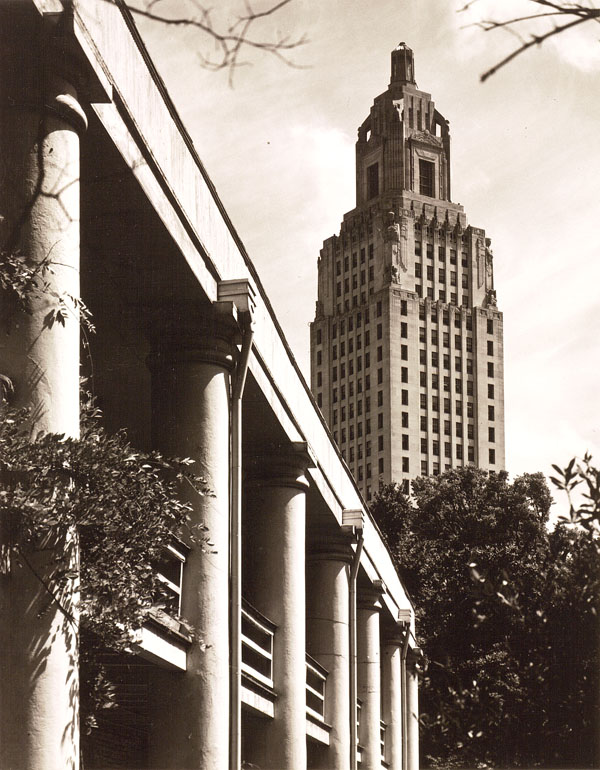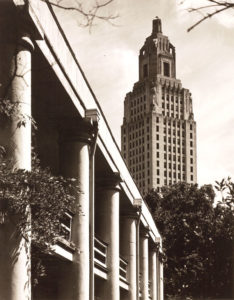Pentagon Barracks
Built in 1819 as a fortification against the Spanish and slave insurrections, today the Pentagon Barracks house a museum, apartments, and the lieutenant governor's office.

Courtesy of Ogden Museum of Southern Art
Old and the New (Pentagon Barracks At LSU with New State Capitol). Morgan, Elemore (Photographer)
The Pentagon Barracks were built to house about 1,000 soldiers stationed at a US military post on the Mississippi River in Baton Rouge. Currently used by the state government, the complex stands in between State Capitol Park and the river.
The Pentagon Barracks were constructed just north of the site of Fort New Richmond, the dirt fort the British built in 1779 during the American Revolutionary War. Spanish forces quickly captured the fort in the September 1779 Battle of Baton Rouge and renamed it Fort San Carlos. In September 1810 West Florida revolutionaries seized the fort from the Spanish and flew the flag of their republic over it, but they surrendered peacefully to the United States in December 1810. As the westernmost fort in the United States at that time, it theoretically provided protection against the Spanish from the direction of the Sabine River as well as from slave rebellions; a major insurrection had taken place in 1811 along the River Parishes. The dirt fort was obviously inadequate, and a major expansion was initiated under the direction of army engineer James Gadsden, who later negotiated the Gadsden Purchase of land from Mexico in 1853.
The four two-story buildings enclose a pentagonal courtyard that is now open on the river side. Originally this fifth side accommodated a commissary-quartermaster structure and adjacent ordnance warehouse, but these were demolished by the 1830s because of their shoddy construction. Monumental Tuscan columns and two-story galleries were built across the fronts of the four buildings facing the courtyard, and identical columns and galleries were added in 1834 to the outer facades, where windows had been installed in 1826. All four buildings are covered by hipped roofs.
Lt. Col. Zachary Taylor, who had been posted to the barracks more than once, was in residence there when elected president in 1848. During the Civil War, both Union and Confederate armies occupied the barracks. Records indicate that the barracks have housed dozens of notable figures who either were garrisoned there or passed through on visits: the list includes William Tecumseh Sherman, P. G. T. Beauregard, Jefferson Davis, George Custer, Ulysses S. Grant, and Abraham Lincoln.
The Baton Rouge post was deactivated in 1879, then leased by Louisiana State University (LSU) and used as dormitories until the university moved to its new campus in 1925. The offices of various state agencies were located in the buildings during the decades that followed, and the Pentagon Barracks were listed on the National Register of Historic Places in 1976. Today the buildings house a museum, the lieutenant governor’s office, and apartments for legislators.
Adapted from Karen Kingsley’s Buildings of Louisiana, part of the Buildings of the United States series commissioned by the Society of Architectural Historians (www.sah.org) and published by Oxford University Press.
